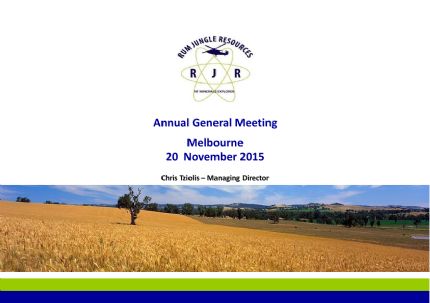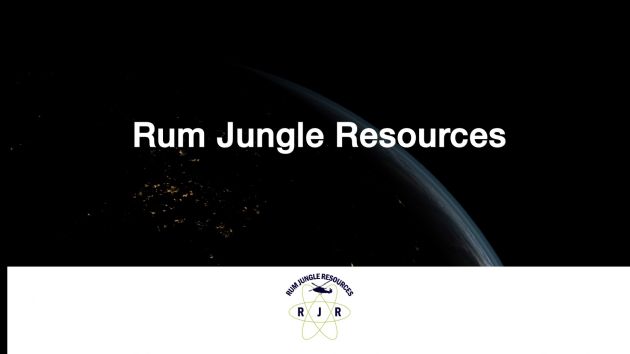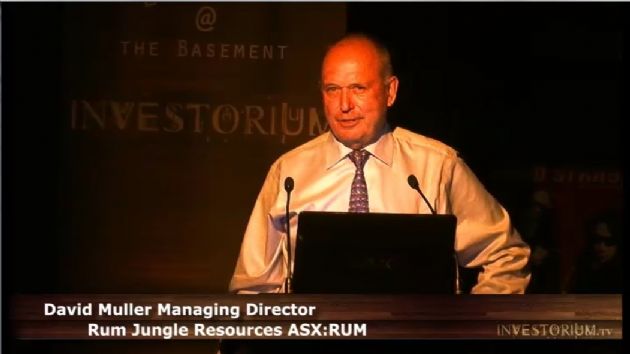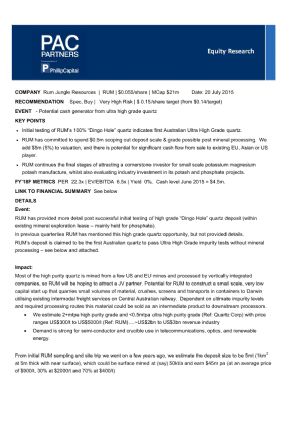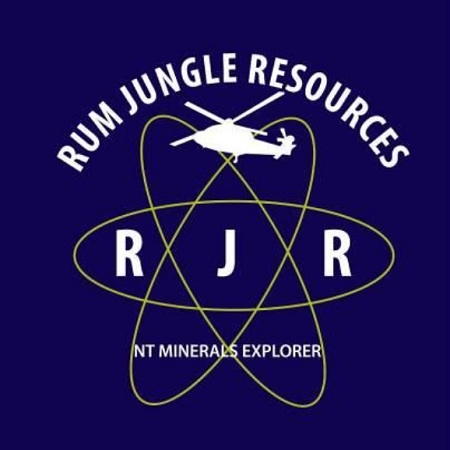 Ammaroo Prefeasibility Study - Update September 15
Ammaroo Prefeasibility Study - Update September 15
Darwin, Sep 9, 2015 AEST (ABN Newswire) - Rum Jungle Resources Ltd ( ASX:RUM) Ammaroo Phosphate Project Preliminary Feasibility Study was completed in September 2014 (ASX announcement 29 September 2014). Completion of the preliminary feasibility study supported the economic and technical potential of the project to be developed as a phosphate rock concentrate export operation or for the production of phosphoric acid or the production of downstream ammonium phosphate fertilisers using proven technologies.
ASX:RUM) Ammaroo Phosphate Project Preliminary Feasibility Study was completed in September 2014 (ASX announcement 29 September 2014). Completion of the preliminary feasibility study supported the economic and technical potential of the project to be developed as a phosphate rock concentrate export operation or for the production of phosphoric acid or the production of downstream ammonium phosphate fertilisers using proven technologies.
The base case economic evaluations have been recently reassessed to take into account long term forecasts of the Australian dollar's value that are considerably lower than previous forecasts, potential labour and other cost reductions in the Australian capital project and resource industry environment, reductions to forecast costs of diesel and gas associated with significant reductions in global prices for oil going forward and a reassessment of phosphate commodity pricing assumptions based on recent price evolution. This revaluation has led to a significant uplift in the potential value of the Ammaroo Phosphate Project.
The Ammaroo phosphate project remains a global-scale, very long life resource, positioned in proximity to existing transport and gas infrastructure and located in a stable OECD country. Currently the majority of the world's seaborne traded phosphate originates from the Middle East and Northern Africa whereby the long term security of supply remains uncertain under a number of realistic scenarios. Australia currently imports approximately 80% of its phosphate requirements from countries such as Morocco, China, Saudi Arabia and the USA.
Moreover, the production of phosphoric acid and the conversion of that acid to ammonium phosphate fertilisers to supply the southern Australian, Indian and regional Asian markets, could be positioned in the first quartile of the global cost curve for delivery to these markets. The low cost position is underpinned by very low costs of mining and processing as the ore is shallow and free digging and easily converted into a rock concentrate suitable as a local phosphoric acid plant feedstock, relatively low costs of gas for ammonia production and proximity to markets in Asia through Darwin and in southern Australian markets that are located in proximity to the southern terminus of the Central Australian Railway.
The following updated economic evaluation baseline for the project provides a basis for continuing engagement with global and regional fertiliser players with a view of securing the necessary strategic, financial, technical and market partnerships needed to move this Tier 1 project towards development.
SUMMARY
The reassessment of the Ammaroo preliminary feasibility study (PFS) baseline economic evaluation was completed on the following existing PFS production scenarios (+/- 25% of capital and operating costs):
- Case A - 2 million tonnes per annum of phosphate rock concentrate (32% P2O5), beneficiated through flotation for export to India and Asia through the port of Darwin
- Case B - 500,000 tonnes per annum of phosphoric acid (100% P2O5) production for export to India and Asia through the port of Darwin
- Case C - 1,020,000 tonnes per annum of di-ammonium phosphate (DAP) and mono-ammonium phosphate (MAP) fertiliser production, utilising the phosphoric acid produced at case B above with the addition of ammonia and granulation capacity for distribution north to export markets and south to Australian markets
Mine Plans
No adjustment has been made to the original PFS mine plans constructed by Coffey Mining. All original mine plans were based on selective mining from only part of the Measured and Indicated resource at a 10% cut off grade within the total JORC resource that was announced to the ASX on 24 March 2014 and has not changed since. The table, in the link below, provides details.
The inventory tonnes identified above represent only a small portion of the total resource (1.145 billion tonnes of phosphate ore at an average grade of 14% P2O5 at a cut-off of 10% P2O5 or 348 million tonnes of phosphate ore at an average grade of 18% P2O5 at a cut-off of 15% P2O5). Accordingly, the Ammaroo resource is potentially a very long life resource and furthermore, with significant regional exploration potential, is the entrée into a significant phosphate province within the Northern Territory.
Exchange Rate
A long run $US/$A exchange rate of $0.70 has been applied to the valuation. This is based on the most recent long run forecasts from a suite of Australian and international banks. The September 2014 valuation utilised a long run exchange rate of $0.80.
Capital and Operating Costs
WorleyParsons, who provided study management and discipline expertise the PFS study, was engaged to reassess capital and operating costs on the basis of continued slowdown in Australia's resources industry and the potential for downward pressure on industry costs. WorleyParsons assessed current pricing of key components using a mix of material/equipment indices and pricing updates from potential suppliers and contractors. Based on this assessment, RUM has identified capital and operating cost reductions of between 1% and 4% for varying categories of capital expenditure and operating costs, mainly associated with labour cost reductions and contractor margins.
Although anecdotal evidence suggests real capital costs in the Australian context may have decreased more significantly over the last 12 months, it should be noted that there is no competitive tension involved in providing PFS level pricing. Accordingly, when the project proceeds to a commercial contracting phase, RUM expects that more significant savings than those garnered through the recent pricing assessment process are possible. The use of second hand or near new equipment and mining fleet could also reduce capital intensity in the future.
Reductions in global oil prices and their associated long term outlook, have enabled reductions in forecasts for diesel and gas prices of approximately 10% in Australian dollar terms for each of the scenarios. Furthermore, reductions to the cost of supplying the selected flotation reagents were identified by WorleyParsons and applied to the operating costs model. Conversely, assumptions regarding sulphur prices for Cases B and C have been revised upwards to reflect current sulphur pricing and the fact that sulphur would be purchased in US dollars which makes it more expensive in Australian dollar terms than previously assumed.
Commodity Prices
The original PFS valuations utilised forecasts of long term prices for phosphate rock concentrate, phosphoric acid and phosphate fertilisers derived from CRU's Ammaroo Phosphate market study from early 2014. Some adjustments have been made to pricing to reflect the current state of phosphate fertilisers globally. Current prices for rock, phosphoric acid and DAP/MAP plus CRU's view of netback due to shipping advantage from Darwin to certain markets over major suppliers and value in use have been utilised in the valuation. Prices are assumed to remain at levels around the current 12 month average until 2018 and then resume the nominal price trajectory previously forecast by CRU.
Phosphate pricing, particularly for phosphoric acid and ammonium phosphate fertilisers, has remained robust over the last 12 months, avoiding the significant declines experienced in iron ore, base metals, coal and oil. This highlights that the industry demand and supply fundamentals are robust and that major players in the industry are behaving rationally with respect to supply expansions.
A further discussion on pricing has been included at Appendix 1 (in link below) to this announcement and NPV sensitivity tables for commodity pricing, exchange rate and capital have been included at Appendix 2 (in link below).
Updated Baseline Valuations
Amended capital, operating costs and price forecasts were provided to Origin Capital who updated the financial models. The following tables outline the key valuation outcomes and therefore the new economic baseline for the Ammaroo Project.
RISKS AND OPPORTUNITIES
In addition to the normal pricing, foreign exchange, financing, contracting, commercial, operational and product specification risks; environmental approvals and native title agreements are not yet in place, but the approvals process has been progressed and is primed to be completed in parallel with a bankable feasibility study.
There are a number of key opportunities that could create value upside:
- Continued geopolitical instability in the Middle East and Northern Africa creating impetus for phosphate price increases or investment, particularly from North American, Indian and Chinese fertiliser companies, in less risky jurisdictions, such as Australia
- Demand and price increases above current forecasts due to increased global growth and consumerism in Asia
- Legislative outcomes associated with the 'Developing Northern Australia' political initiative and regional free trade agreements could include measures to help create competitive advantage
- Potential for further cost reductions and productivity improvements in Australia as mining and oil and gas construction declines over the next few years
- Leveraging Australia's leading position in mining and processing automation and remote operations control in increasing productivity and lowering operating costs. This has not been considered in the PFS but will form a key component of a bankable feasibility study
- Opportunities that might exist to procure second hand capital equipment including ammonia plants, phosphoric acid plants, mining fleet and train rolling stock
- The value potential of the combination of RUM's Sulphate of Potash projects combined with the production of phosphate to produce compound NPK fertilisers with micro-nutrient additives to capture higher value segments of the market. This has not been considered in the PFS but is an opportunity.
Capital and operating cost estimations have been derived through a combination of market testing for budget pricing, analysis of current enterprise bargaining agreements and benchmarking on recent projects. None of it has been derived from competitive commercial negotiations. It is reasonable to assume that the current view of capital and operating costs incorporates some level of industry inertia to retain costs associated with the recent construction boom in mining and oil and gas. As these current projects are completed, there should be opportunity for unique projects such as this, to take advantage of the cycle downturn.
MOVING FORWARD
RUM's medium term objective is to take one of the development options forward to a bankable feasibility study, government approvals and development. The most likely source of near term funding to advance these very large capital and reasonably complex projects is through the establishment of a joint venture and associated off-take agreements. Rum Jungle Resources commenced a global process to engage the fertiliser industry in early 2015 with a view of securing cornerstone industry investment into the project. Moreover, a cornerstone industry partner would determine the product strategy and therefore which project option to take into a bankable feasibility study. To date, a transaction that recognises reasonable value for entry into the project has not been completed but a number of discussions are ongoing with fertiliser industry participants.
It is important to note that potential development partners will have differing strategies regarding investment in the phosphate fertiliser space and what products will generate the most value in certain markets. For example, there may be Indian or Indonesian phosphate fertiliser producers looking to secure their supply of rock to underpin their existing or new investments in down stream production capacity in their home markets. Alternately, a large North American fertiliser producer may be looking to integrate upstream to fertiliser production in the Australasian region to underpin their previous investments in retail distribution infrastructure or to access growth markets more readily or Chinese producers looking to establish offshore production to better access export markets.
The company is also in the fortunate position of being able to progress smaller scale, lower capital projects such as the Karinga Lakes Sulphate of Potash Project and potentially the Dingo Hole Silica project, that may enable nearer term cash flows to be realised that could subsequently be utilised to underpin the advancement of the Ammaroo Phosphate Project in time.
Shareholders are reminded that the completion of a pre-feasibility study in September 2014, and indeed this revaluation, does not mean that the project is financeable and that no financing decision has been made to develop the project.
Appendix 1 - Phosphate product price discussion and analysis (in link below).
Appendix 2 - Sensitivity analysis (in link below).
To view the tables and Appendix 1 & 2, please visit:
http://media.abnnewswire.net/media/en/docs/ASX-RUM-429476.pdf
About Verdant Minerals Ltd
 Verdant Minerals Ltd's (ASX:VRM) strategic intent is to create shareholder value through the discovery, development and operation of fertiliser and industrial mineral projects, located in close proximity to existing transport infrastructure, with a primary focus on the Northern Territory of Australia.
Verdant Minerals Ltd's (ASX:VRM) strategic intent is to create shareholder value through the discovery, development and operation of fertiliser and industrial mineral projects, located in close proximity to existing transport infrastructure, with a primary focus on the Northern Territory of Australia.
![abnnewswire.com]()
Related Companies
Social Media
Share this Article

 ASX:RUM) Ammaroo Phosphate Project Preliminary Feasibility Study was completed in September 2014 (ASX announcement 29 September 2014). Completion of the preliminary feasibility study supported the economic and technical potential of the project to be developed as a phosphate rock concentrate export operation or for the production of phosphoric acid or the production of downstream ammonium phosphate fertilisers using proven technologies.
ASX:RUM) Ammaroo Phosphate Project Preliminary Feasibility Study was completed in September 2014 (ASX announcement 29 September 2014). Completion of the preliminary feasibility study supported the economic and technical potential of the project to be developed as a phosphate rock concentrate export operation or for the production of phosphoric acid or the production of downstream ammonium phosphate fertilisers using proven technologies. Verdant Minerals Ltd's (ASX:VRM) strategic intent is to create shareholder value through the discovery, development and operation of fertiliser and industrial mineral projects, located in close proximity to existing transport infrastructure, with a primary focus on the Northern Territory of Australia.
Verdant Minerals Ltd's (ASX:VRM) strategic intent is to create shareholder value through the discovery, development and operation of fertiliser and industrial mineral projects, located in close proximity to existing transport infrastructure, with a primary focus on the Northern Territory of Australia.



